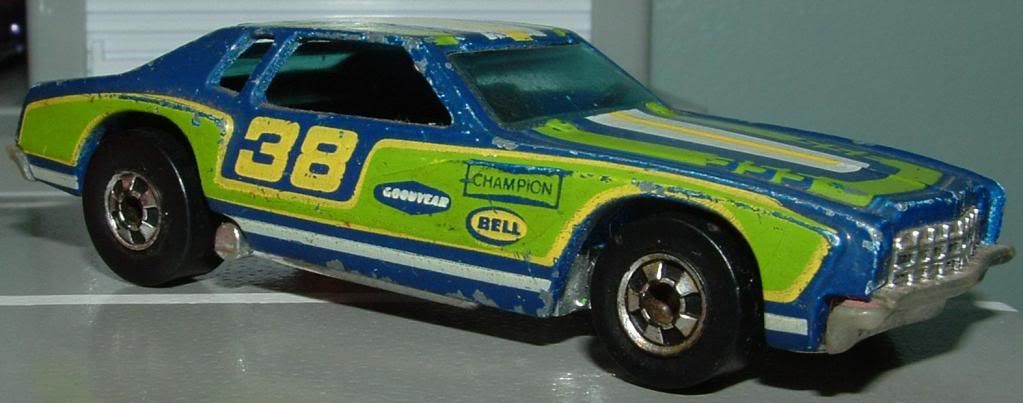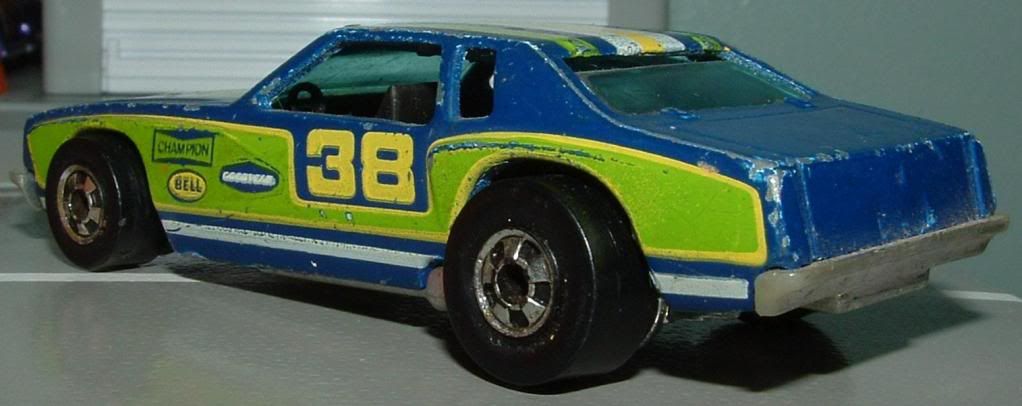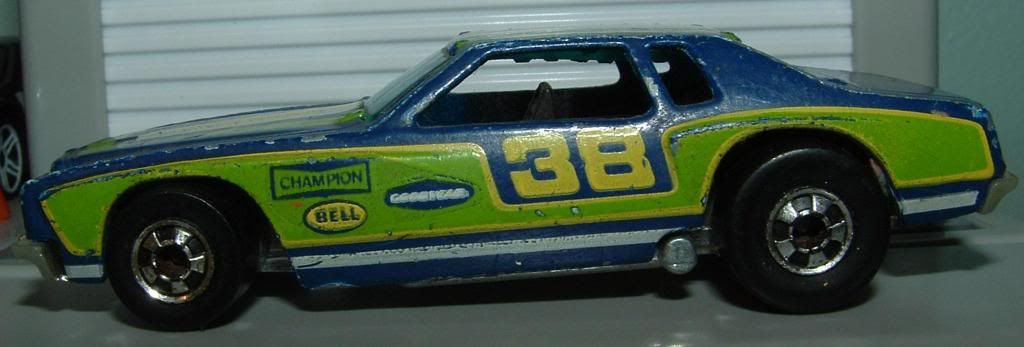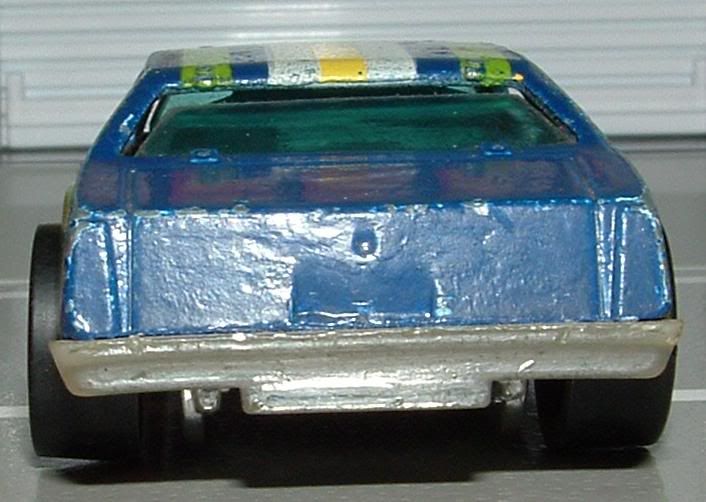
A blog focusing on 1/64 diecast from such popular brands as Hot Wheels, Matchbox, Johnny Lightning, M2 Machines, GreenLight, Tomica, Yat Ming, Majorette, MotorMax, Siku, Corgi, Guisval, Playart, Ertl, Zylmex, Racing Champions, & many more. Swifty's Garage features a daily Car Of The Day and news updates from your favorite brands!
Friday, October 14, 2011
Car Of The Day: October 14, 2011
Today's car of the day is Hot Wheels' 1974 Chevrolet Monte Carlo.
The Chevrolet Monte Carlo is an American-made two-door coupe introduced for model year 1970, and manufactured over five generations through model year 2007. It was marketed as a personal-luxury coupe through most of its history, with the last model version being classified as a full-sized coupe. When it was discontinued in 2007, it had outlived many competitors that were either discontinued many years earlier or changed in concept to either a four-door sedan or small sport coupe.
The Monte Carlo endured five design generations. The first three (1970–72, 1973–77, 1978–80 and 1981–88) were of a rear-wheel-drive, V8-powered (V6 available beginning in 1978) coupe style, utilizing separate body-on-frame construction. The later rear-wheel-drive generations bucked the trend of unit-body construction, along with smaller engines, that became more prevalent in the early 1980s as automakers downsized their vehicle lines to meet increasing stringent fuel-economy regulations in the aftermath of two energy crises that led to gasoline shortages and skyrocketing pump prices in 1973-74 and 1979-80. Despite those trends, the Monte Carlo remained a popular seller and even regained the SS version (initially offered for 1970-71 with 454 cubic-inch V8) from mid-1983 to 1988 with a high-performance 305 cubic inch V8.
Following a several year hiatus following the discontinuation of the rear-drive Monte Carlo after 1988, the nameplate was revived for 1995 on a front-drive, V6-powered coupe based on the Chevrolet Lumina sedan. It was succeeded by the fifth and final-generation Monte Carlo in 2000 that was built along-side of the Chevrolet Impala, which succeeded the Lumina as Chevy's mid-sized sedan. The Monte Carlo SS was revived from 2000 to 2007, initially powered by 3.8-liter V6 (supercharged in 2004-2005), which was replaced by a 5.3-liter V8 for 2006-2007.
For more information and pictures of the real car please visit: Chevrolet Monte Carlo
I have no idea why this is such an expensive piece to obtain. This one was marked $20 but I talked him down to $15 and still feel like I overpaid. But this is about a $50 car mint. Considering it shares a base, interior and winshield with the Torino Tornado and is a far from accurate Monte Carlo I don't see the popularity. But I love this particular paint scheme and it's been among my most wanted models for years. And now its finally mine- I just wish it was in better shape.
A redesigned Monte Carlo was introduced alongside other GM intermediates. Like other GM mid-size cars, the 1973 Monte Carlo was no longer a hardtop, but a pillared coupe with rear side opera windows and frameless door glass. Prominent styling features included dual headlights flanking an egg-crate grille with a Monte Carlo emblem in front and vertical taillights above the bumper. The front bumper was a large federally mandated 5 mph (8.0 km/h) bumper that was among the required 1973 federal safety standards for all passenger cars sold in the U.S. with the 5 mph (8.0 km/h) requirement extended to rear bumpers on 1974 models. Also new was a double-shell roof for improved noise reduction and rollover protection along with the flush-mounted pull-up exterior door handles first introduced on the 1970½ Camaro and 1971 full-sized Chevrolets and Vegas.
The separate body-on-frame construction carried over for 1973, as was the basic all-coil suspension.
For improved ride and handling, the 1973 Monte Carlo featured a number of innovations (for a large American car) such as standard radial-ply tires, Pliacell shock absorbers, high-caster steering, and front and rear anti-roll bars (previously offered only with the SS package). The standard Monte Carlo with manual transmission, retained "traditional" steering and bias-ply tires, but the radial-tuned system was included when the automatic transmission was ordered, earning the Monte Carlo S label.
A new model for 1973 was the Monte Carlo Landau, which was basically an "S" with a rear quarter Landau vinyl roof, Turbine II wheels and driver and passenger-side sport mirrors.
The interior of the 1973 Monte Carlo featured an all-new, wraparound cockpit-style instrument panel, similar to that found in some contemporary Pontiacs, Oldsmobiles and Buicks, in which gauges and various instruments were centered within easy reach of the driver. The simulated burl elm trim was retained. A split bench seat was standard, but "Strato Bucket" seats of a new design were optional, along with a floor console featuring an equally new shifter with knob and button similar to Pontiac's Rally Sports Shifter replacing the Buick-like horseshoe shifter of previous years, and storage compartment. The bucket seats were of a one-piece high-back design with built-in headrests, and could swivel some 90 degrees to permit the driver and front passenger easier entry and exit. Cloth and vinyl trims were offered with both the bench and bucket seats.
The standard engine was a 145 (net) hp (108 kW) 350 CID (5.7 L) Turbo-Fire V8. Optional engines included a 175 (net) hp (30 kW) 350 CID V8 with a four-barrel carburetor and a four-barrel carbureted 454 CID Turbo-Jet V8 rated at 245 (net) hp (183 kW).
The 1973 Monte Carlo was named Motor Trend's "Car of the Year", due to its new styling and emphasis on Euro-style ride and handling. The 1973 Monte Carlo set a new sales record for Chevrolet, with nearly 250,000 sold for the model year.
The success of the Monte Carlo and Pontiac's similar Grand Prix led to several new personal luxury cars from competitors, including subsequent Mercury Cougar, the Ford Torino Elite, the Chrysler Cordoba and restyled Dodge Charger, and even high-line versions of the AMC Matador, which got a swoopy new coupe design for 1974.
The 1974 Monte Carlo received only minor detail changes from its 1973 predecessor, most notably a revised grille in the front and taller and slimmer vertical taillights in the rear, along with a relocated license plate and larger 5 mph (8.0 km/h) rear bumper.
The base Monte Carlo with manual transmission, standard suspension and bias-ply tires was discontinued, leaving only the "S" and "Landau" models equipped with radial-ply tires and upgraded suspensions along with standard power steering and front disc brakes.
A three-speed manual transmission was listed as standard equipment on 1974 "S" and "Landau" models equipped with the standard 350 CID V8, and an automatic transmission was a required option with the larger 400 and 454 CID V8s. However, a number of sources indicate that Chevrolet built virtually all 1974 Monte Carlos with the Turbo Hydra-Matic transmission.
The standard 350 CID Turbo-Fire V8 was again rated at 145 hp (108 kW) with two-barrel carburetor in 49 states. For Californians, the standard engine was a 350 Turbo-Fire V8 with a four-barrel carburetor rated at 160 hp (120 kW) that was not offered in the other 49 states. Reappearing on the Monte's option list for the first time since 1970 was a 400 CID Turbo-Fire small block V8 rated at 150 hp (110 kW) with a two-barrel carburetor (not offered in California) or 180 hp (134 kW) with a four-barrel carburetor. The top engine was again the 454 CID Turbo-Jet big block V8 rated at 235 hp (183 kW).
Despite the Arab Oil Embargo of late 1973 and early 1974 that greatly cut into sales of standard and intermediate-sized cars in favor of smaller compacts and imported subcompacts, the Monte Carlo went the other way on the sales charts by setting a new sales record this year of over 300,000 units despite the long lines at gas stations and record-high gasoline prices. The Monte Carlo continued to lead in intermediate personal luxury car sales with the Grand Prix placing second and the arrival of new competitors this year, including an upsized Mercury Cougar, Ford Torino Elite and AMC's Matador coupe. Chrysler would introduce its entries in this field for 1975 including the Chrysler Cordoba and redesigned Dodge Charger.
Subscribe to:
Post Comments (Atom)






No comments:
Post a Comment